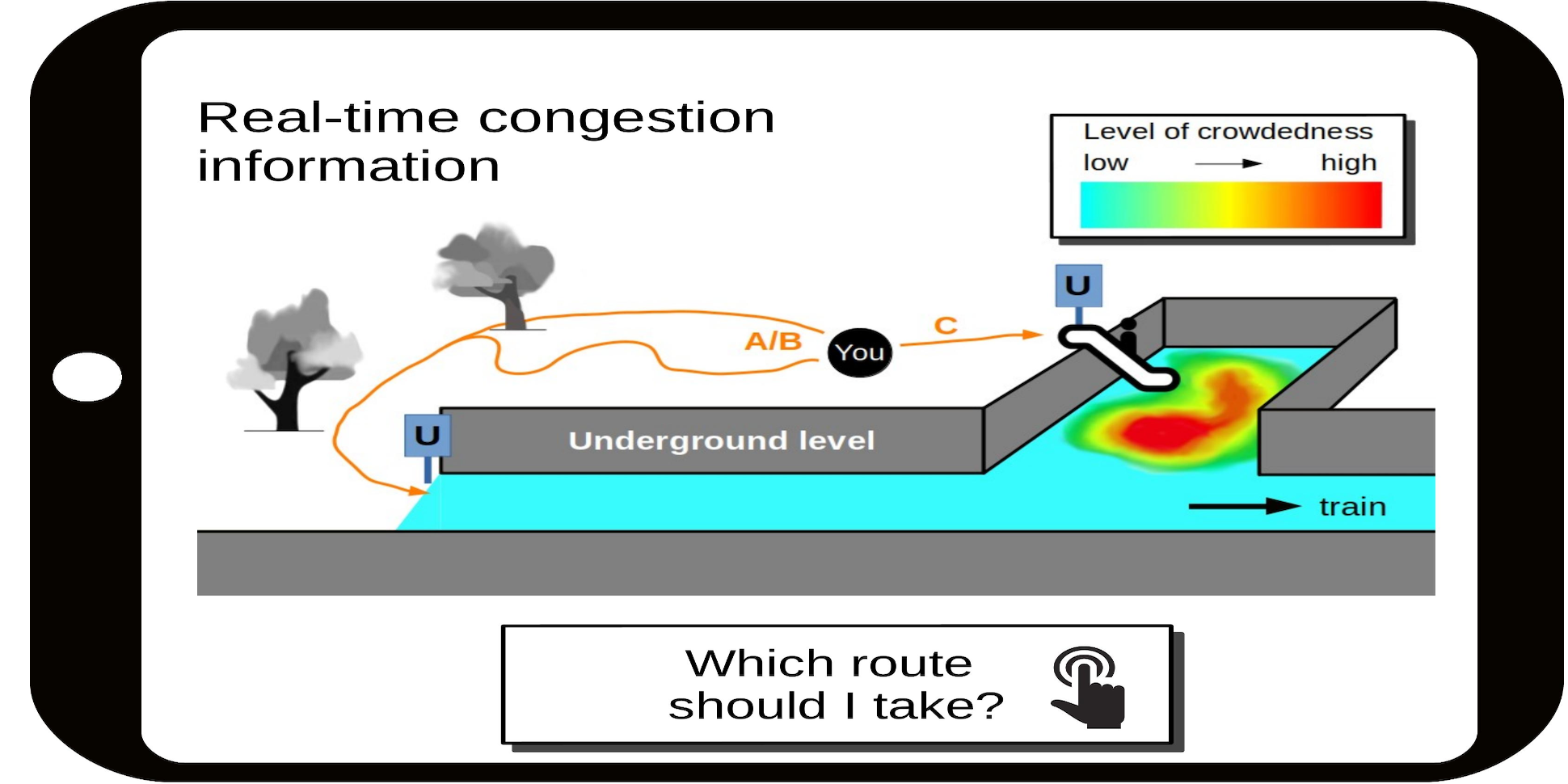Estimating Pedestrian Flows Using Route Distributions and Sparse Counting Data
DOI:
https://doi.org/10.17815/CD.2024.149Keywords:
Crowd management, Count study, Online Survey, Pedestrians, TrafficAbstract
At metro station Münchner Freiheit in Munich soccer fans cause congestion before and after soccer matches on the shortest route to get from a bus station to the metro. Yet, an online survey suggests that, given the right information and incentive through a mobile app, fans are willing to take a detour. In this study we combine the survey results with passenger counts collected in a field study to quantitatively estimate the number of rerouted pedestrians in dependency of influx from a side entrance for which there is no data. We find a realistic range for the change in flow, despite incomplete measurement data, that we use as input for predictive simulations. The quantitative results are also helpful for traffic management.
References
Mayr, C.M., Köster, G.: Guiding crowds when facing limited compliance: Simulating strategies. PLOS ONE 17(11), 1-24 (2022). doi:10.1371/journal.pone.0276229
Mayr, C.M., Templeton, A., Köster, G.: Designing mobile application messages to impact route choice: A survey and simulation study. PLOS ONE 18(4), 1-20 (2023). doi:10.1371/journal.pone.0284540
Feliciani, C., Murakami, H., Shimura, K., Nishinari, K.: Efficiently informing crowds - experiments and simulations on route choice and decision making in pedestrian crowds with wheelchair users. Transportation Research Part C: Emerging Technologies 114, 484-503 (2020). doi:10.1016/j.trc.2020.02.019
Beale, L., Field, K., Briggs, D., Picton, P., Matthews, H.: Mapping for wheelchair users: Route navigation in urban spaces. Cartographic Journal 43, 68-81 (2006). doi:10.1179/000870406X93517
Neis, P.: Measuring the reliability of wheelchair user route planning based on volunteered geographic information. Transactions in GIS 19(2), 188-201 (2015). doi:10.1111/tgis.12087
Bertel, S., Dressel, T., Kohlberg, T., Jan, V.: Spatial knowledge acquired from pedestrian urban navigation systems. In: MobileHCI 2017, Proceedings of the 19th International Conference on Human-Computer Interaction with Mobile Devices and Services, pp. 1-6 (2017). doi:10.1145/3098279.3098543
Carter, H., Drury, J., Amlôt, R., Rubin, G.J., Williams, R.: Effective responder communication improves efficiency and psychological outcomes in a mass decontamination field experiment: Implications for public behaviour in the event of a chemical incident. PLoS ONE 9(3), e89846 (2014). doi:10.1371/journal.pone.0089846
Carter, H., Amlôt, R., Williams, R., Rubin, G.J., Drury, J.: Mass casualty decontamination in a chemical or radiological/nuclear incident: Further guiding principles 2016. PLoS Currents (2016). doi:10.1371/currents.dis.569a83b893759346e511a070cb900d52.
Reicher, S., Spears, R., Haslam, S.A.: The social identity approach in social psychology. In: The SAGE Handbook of Identities, pp. 45-63 (2010). doi:10.4135/9781446200889
Levine, M., Prosser, A., Evans, D., Reicher, S.: Identity and emergency intervention: how social group membership and inclusiveness of group boundaries shape helping behavior. Personality and social psychology bulletin 31(4), 443-453 (2005). doi:10.1177/0146167204271651

Downloads
Published
How to Cite
Issue
Section
Categories
License
Copyright (c) 2024 Christina Maria Mayr, Gerta Köster

This work is licensed under a Creative Commons Attribution 4.0 International License.
Authors contributing to Collective Dynamics agree to publish their articles under the Creative Commons Attribution 4.0 license.
This license allows:
Share — copy and redistribute the material in any medium or format
Adapt — remix, transform, and build upon the material
for any purpose, even commercially.
The licensor cannot revoke these freedoms as long as you follow the license terms.
Authors retain copyright of their work. They are permitted and encouraged to post items submitted to Collective Dynamics on personal or institutional websites and repositories, prior to and after publication (while providing the bibliographic details of that publication).








